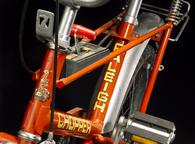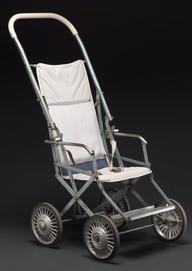





This French chaise was built in approximately 1750 in France by an unknown maker. It is a lightweight, two-wheeled, carriage designed to be pulled by a single horse, chaises were meant for quick and agile transport for individuals.
This particular French chaise is heavily decorated and ornately designed and detailed. This includes elaborate carvings on the wheels, shafts and other wooden parts of the carriage, which have been covered in a dark varnish. It also has (now faded) painted panels on the front, back and the sides of the body, depicting birds and other scenes of nature.
The single seat is covered with dark green/brown cushioning.
Mechanically, this chaise is very simple, with no undercarriage components other than the axle and wheels and the leather braces which the body is suspended on. The chaise has no braking system.
The French word chaise means chair, and chaises were early forms of gigs, which generally refers to a simple, two-wheeled, one seat carriage designed to be pulled by one (but sometimes two) horses. Chaises were used for a range of purposes, with one of their earliest roles being transporting mail because they were fast and maneuverable.
Chaises (especially those of French design) were also very popular as luxury vehicles for wealthy aristocratic women to take leisure rides. The carriages were often referred to as ‘chaise de promenade,’. These chaises were usually expensively and exquisitely detailed and ornamented so that they became moving displays of wealth, status and style. In the 18th and 19th century, chaises made in France were very popular among the upper classes, primarily owing to the detail and ornate craftmanship of French coachbuilders.
The design of this French chaise suggests that it likely had a career as a ‘chaise de promenade’ for a wealthy family.
The single seated design of chaises meant that women would often drive their own carriages, without the aid of a coachman, which potentially gave them a certain level of independence, although it was only a choice for the very wealthy.
Details
- Category:
- Road Transport
- Object Number:
- 1938-664
- Materials:
- wood (unidentified), metal (unknown), paint and textile
- Measurements:
-
overall: 1900 mm x 1800 mm x 4300 mm,
- type:
- chaise
- credit:
- Mrs. E. Bagshaw.




